|
Boletín de la Sociedad Geológica Mexicana Volumen 74, núm. 1, A250821, 2022 http://dx.doi.org/10.18268/BSGM2022v74n1a250821
|
 |
Disconformity between the El Abra Formation underlying the “Temazcal unit” in Cerro Quemado locality, Temazcal, San Luis Potosí, Mexico: Biostratigraphy and microfacies analysis
Disconformidad entre la Formación El Abra, subyaciendo la “unidad Temazcal” en la localidad Cerro Quemado, Temazcal, San Luis Potosí, México: bioestratigrafía y análisis de microfacies
Lourdes Omaña 1,*, Rubén Alfonso López Doncel 2, José Ramón Torres Hernández 2, José Rafael Barboza Gudiño 2
1 Departamento de Paleontología, Instituto de Geología, Universidad Nacional Autónoma de México, Ciudad Universitaria, 04510, CDMX, Mexico.
2 Instituto de Geología, Universidad Autónoma de San Luis Potosí, Av. Dr. Nava # 5, San Luis Potosí, Mexico.
* Corresponding author: (L. Omaña) This email address is being protected from spambots. You need JavaScript enabled to view it.
How to cite this article:
Omaña, L., López Doncel, R.A., Torres Hernández, J.R., Barboza Gudiño, J.R., 2022, Disconformity between the El Abra Formation underlying the “Temazcal unit” in Cerro Quemado locality, Temazcal, San Luis Potosí, Mexico: Biostratigraphy and microfacies analysis: Boletín de la Sociedad Geológica Mexicana, 74 (1), A250821. http://dx.doi.org/10.18268/BSGM2022v74n1a250821
ABSTRACT
On the western part of the Valles–San Luis Potosí Platform located in Cerro Quemado near Temazcal, municipality of Armadillo de Los Infante, two sequences crop out. The lower one is the shallow-water El Abra Formation of the mid–upper Cenomanian, unconformably covered by a deep-water deposit of the upper Maastrichtian informally called here the “Temazcal unit.” The succession presents a nonconforming contact between these two sedimentary units, displaying a hiatus as the result of a time of non-deposition in the sedimentary record, showing a subaerial exposure with erosion yielding topographic relief. Based on the lithological changes from the underlying limestone toward the overlying silty limestone, as well as a detailed biostratigraphic study based on foraminiferal associations that provide an accurate dating, it has been possible to estimate the magnitude of the hiatus, which spans from the lower part of the Turonian, including the Coniacian, the Santonian, and possibly the lower part of the Maastrichtian.
Keywords: Disconformity, El Abra Formation, “Temazcal unit”, San Luis Potosí, Mexico.
RESUMEN
En la parte occidental de la Plataforma Valles-San Luis Potosí en la localidad cerro Quemado cercano a El Temazcal, municipalidad de Armadillo de Los Infante, afloran dos secuencias: una inferior de aguas someras de la Formación El Abra del Cenomaniano medio-superior y, sobreyaciendo en discordancia, un depósito de aguas profundas del Maastrichtiano superior llamado informalmente “unidad Temazcal”. El contacto discordante entre estas dos unidades sedimentarias mostró un hiatus como resultado de un tiempo de no depósito en el registro sedimentario, combinado con la erosión y que produjo un relieve topográfico. Sobre la base de los cambios litológicos desde la caliza subyacente hacia la caliza limosa, así como del estudio bioestratigráfico detallado basado en las asociaciones foraminiferales, se ha establecido una datación precisa, haciendo posible estimar la magnitud del hiatus, que se extiende desde la parte inferior del Turoniano, incluyendo el Coniaciano, el Santoniano y posiblemente la parte inferior del Maastrichtiano.
Palabras clave: Disconformidad, Formación El Abra, “unidad El Temazcal”, San Luis Potosí, México.
- Introduction
The El Abra Formation was deposited on the isolated Valles–San Luis Potosí Platform (VSLPP), which had its maximum growth during the Albian–Cenomanian, as has been stated by Carrillo-Bravo (1971), and by Wilson and Ward (1993). A disconformity has been recorded between the limestone of El Abra Formation and the overlying pelagic deposits of the Upper Cretaceous. The El Abra Formation on the eastern part of the VSLPP was drowned abruptly from the Turonian by the deposit of the Agua Nueva (Turonian), San Felipe (Coniacian–Santonian) and Méndez (Campanian–Maastrichtian) formations (Basáñez et al., 1993).
In the western part of the VSLPP, the El Abra Formation is overlain by the pelagic Soyatal Formation, deposited during the flooding of the platform in the latest Cenomanian (Omaña et al., 2012). The Soyatal Formation ranges up to the late Santonian (Omaña et al., 2013). During the Campanian–Maastrichtian, the Cárdenas Formation was deposited over the Soyatal Formation (Cserna and Bello-Barradas, 1963). The facies change toward the basin setting could correspond to the Caracol Formation (López-Doncel, 2003).
Late Cretaceous–Eocene Laramide orogeny caused thrusting and folding of the Cretaceous marine successions deposited along the VSLPP (Suter, 1984, 1987, 1990; Fitz-Díaz et al., 2018). The eastern margin of the platform is exposed in quarries along the Cuesta de El Abra near Valles and Antiguo Morelos (km 541–546 of the San Luis Potosí–Tampico railway). Part of its western edge crops out extensively and can be seen along road cuts 30 km east of the city of San Luis Potosí.
The aim of this study is to report the unconformable transition between two sequences; the shallow-water deposit of the El Abra Formation and the overlying deep-water deposit informally termed the “Temazcal unit” from a succession of the Cerro Quemado located in the western part of the Valles–San Luis Potosí Platform.
In addition to the analysis of the stratigraphic relationship between the two units, including subaerial profiles, a petrographic and a detailed foraminiferal study of the El Abra and especially of the “Temazcal unit” was carried out to document the magnitude of the hiatus in the reviewed succession.
- Geological setting
The studied area is located in the western part of the VSLPP in the Cerro Quemado, near the village of Temazcal, 55 km northeast of the city of San Luis Potosí (Figure 1).
 |
| Figure 1. Geological map with location of the outcrops in the Cerro Quemado (modified from Labarthe-Hernández et al., 1982). |
The VSLPP is part of an extensive carbonate platform system at the western side of the ancestral Gulf of Mexico and represents the westernmost end of the ancient Tethys Ocean during late Early Cretaceous. It was one of “the largest isolated carbonate platforms (200 by 300 km), which commenced to develop in Early Cretaceous and achieved maximum growth during the Albian, when it evolved to a rimmed shelf margin” (Wilson and Ward, 1993).
Salvador (1991) stated that throughout the Early Cretaceous, the Gulf of Mexico Basin had a well-known tectonic stability, with reduced terrigenous input that enabled the expansion of stable shelves, ramps and platforms bordering the deep central part of the Gulf of Mexico Basin. This became the site of widespread carbonate deposition, particularly during the Albian–Cenomanian, when carbonate deposition extended from the Bahamas along the northern rim of the Gulf, across Mexico to the Yucatán Peninsula, and to various Caribbean localities (Scott, 1990).
- Material and methods
The studied material was collected from an outcropping succession in the Cerro Quemado (CQ) located near the village of El Temazcal at the coordinates (22º 23’ 24.65” N; 100º 30’ 29.69” W), 55 km northeast of the city of San Luis Potosí. It consists of limestone that corresponds from to the uppermost part of the El Abra Formation, which is overlain by a silty limestone, corresponding to the base of what is informally called the “Temazcal unit.” The 10 CQ samples were processed in 45 thin sections for identification of the foraminifera in order to determine the age, and a microfacies analysis was undertaken to infer the depositional environment.
The thin sections are housed in the Paleontological Collection of the Institute of Geology (Universidad Nacional Autónoma de México).
- Results and discussion
In the locality of Cerro Quemado, we observed an erosional surface that separates the El Abra Formation from younger strata represented by a succession informally named the “Temazcal unit.” This gap represents a time of non-deposition combined with erosion (Figure 2).
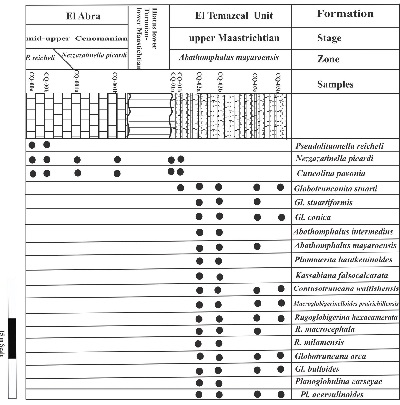 |
| Figure 2. Stratigraphic column with the studied samples. |
4.1. THE EL ABRA FORMATION
The older lithostratigraphic unit included in this study is the upper part of the El Abra Formation, deposited on a carbonate platform during the Late Cretaceous. The term El Abra limestone was first applied to the shallow-water carbonate of the Sierra El Abra (cf. Muir, 1936, p. 36), which is characterized by very thick and poorly defined bedding (Figure 3a) containing a great variety of invertebrates, mostly rudists and other bivalves, as well as gastropods, echinoderms, larger foraminifera and calcareous algae (Bonet, 1956; Alencáster and García-Barrera, 2008; Buitrón-Sánchez et al., 1995; Omaña et al., 2012; 2019).
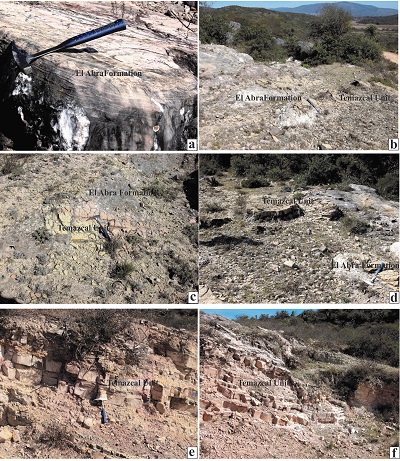 |
| Figure 3. View of the outcrops in the Cerro Quemado locality. a) The El Abra Formation outcrop showing the limestone thick bedding; b-d) A panoramic view that shows the contact between the El Abra limestone forming a topographic profile and the overlying “Temazcal unit”; e-f) Pictures of the “Temazcal unit” composed of thick and thin argillaceous limestone layers. |
The larger foraminifera identified from this unit in the CQ succession are Pseudolituonella reicheli Marie, Nezzazata simplex Omara, Daxia cenomana Cuvillier and Szakall, Peneroplis parvus de Castro, Minouxia inflata Marie, Cuneolina parva Henson, C. pavonia d’Orbigny, Nezzazatinella picardi (Henson) and miliolids. We assume that it corresponds to the Pseudolituonella reicheli Assemblage Zone.
The microfacies of the interval is a benthic foraminiferal packstone/grainstone, well sorted, sub-rounded micritic intraclasts are associated with peloids and diverse benthic foraminifera association, including miliolids and Peneroplis, Daxia, Pseudolituonella, fragments of mollusk are common. These components have a chaotic orientation and are densely packed. Some bioclasts exhibit an irregular micrite envelope. Sparry calcite cement fills inter- and intragranular and pores. (Figure 4a). It could be compared to Standard Microfacies Type (SMF 18) of Flügel (2010), indicating a shallow-water marine environment.
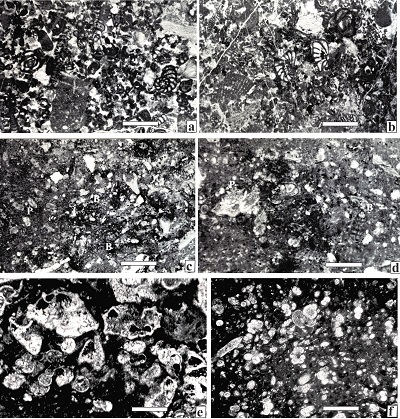 |
| Figure 4. Microfacies in the boundary between the El Abra Formation and the “Temazcal unit”, showing the lithological and micropaleontological differences. a) Benthic foraminiferal packstone/grainstone with benthic foraminifera from the upper part of the El Abra Formation, Sample CQ- 00a-1; b) Benthic foraminiferal packstone–grainstone with Peneroplis, Nezzazatinella, Cuneolina from the uppermost part of the El Abra limestone, Sample CQ-001(1); c-d) Mixture of benthic (B) and planktic foraminifera (P) that extends from the El Abra Formation into the overlying unit; c = Sample CQ-01(1); d = Sample CQ-01(2); e) Wackestone with planktic foraminifera characteristic of the “Temazcal unit”; e = Sample CQ-03 (2); f = Sample CQ-02b (7). Scale bar 100 µm in a – d. Scale bar 200 µm in e. |
4.2. THE “TEMAZCAL UNIT”
We propose the name “Temazcal unit” as an informal name for an outcropping located at the Cerro Quemado (22º 23’ 24.65” N; 100º 30’ 29.69” W), municipality of Armadillo de los Infante in the state of San Luis Potosí. This lithological unit consists of thin and thick layers of gray to green silty limestone that has weathered to a reddish color (Figure 3e, 3f). The base of the unit unconformably overlies the El Abra Formation and there are no other marine layers covering it in the area. In the contact between the two units, we observed evidence of an ancient sub-aerial exposure that had allowed the development of significant topographic relief as result of erosion (Figure 3b to 3d).
The foraminiferal association in the uppermost part of the El Abra Formation, underlying the Temazcal unit, is composed mostly of Nezzatinella picardi (Henson), Cuneolina parva Henson, and miliolids (Nezzazatinella picardi Interval Zone) (Figure 4a) of mid–late Cenomanian age (Omaña et al., 2019), the microfacies is a foraminiferal packstone/grainstone as the above described, but with a different benthic foraminiferal assemblage. It could be compared to Standard Microfacies Type (SMF 18) of Flügel (2010), indicating a shallow-water marine environment (Figure 4b).
Upward, a mixture of benthic and planktic foraminifera is recorded. In the shift towards the Temazcal unit, the microfacies is an intraclastic-bioclastic wackstone/packstone benthic foraminiferal, cuneolinids, nezzazatinellids (Figure 4c), observed together with planktic foraminifera as globotruncanids and rugoglobigerinids (Figure 4d). Subrounded intraclasts containing peloids, are also present. These components are embedded within a dark-colored micritic matrix commonly neomorphosed to microspar. Some intraskeletal pores are filled with sparry calcite. Bioclasts are usually silicified. Over it, a planktic foraminiferal wackstone/packstone, these microfossils are the only bioclast present in this microfacies. These components are embedded within a dark-colored micritic matrix neomorphosed to microspar. A distinct feature is the occurrence of planar lamination. Laminae are differentiated by the content of grains. Usually, bioclasts are oriented parallel to the lamination. We infer a pelagic deep-water basinal facies (FZ 1) of Wilson (1975) or SMF 3 according to Flügel (2010) (Figure 4e, 4f).
Within the “Temazcal unit,” the planktic foraminiferal association is reported and illustrated for the first time in this area; it consists of Abathomphalus mayaroensis (Bolli), A. intermedius (Bolli), Plummerita hantkeninoides (Brönnimann), Trinitella scotti (Brönnimann), Kassabiana falsocalcarata (Kerdany and Abdelsalam), Planoglobulina acervulinoides (Egger), Globotruncanita conica (White), G. stuarti (de Lapparent), G. stuartiformis (Dalbiez), Contusotruncana walfishensis (Todd), Globotruncana arca (Cushman), G. bulloides Vogler, G. hilli Pessagno, G. falsostuarti Sigal, Rugoglobigerina macrocephala (Brönnimann), R. hexacamerata (Brönnimann), R. milamensis Smith and Pessagno, Planoglobulina carseyae (Plummer) (Figures 5 to 7).
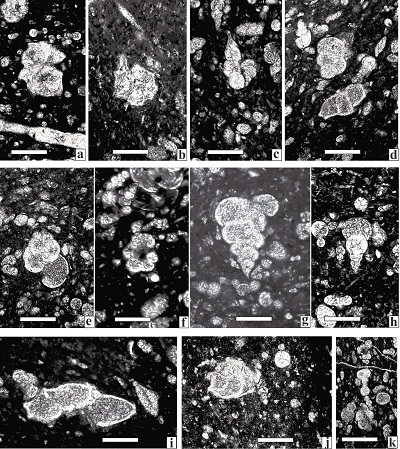 |
| Figure 5. Late Maastrichtian Planktic foraminifera from the “Temazcal unit”. a) Kassabiana falsocalcarata (Kerdany and Abdelsalam) transversal section, Sample CQ-02b (7); b-c) Plummerita hantkeninoides (Brönnimann) transversal section, Sample CQ-02a (4), c) axial section, Sample CQ-02b (5); d) Rugoglobigerina macrocephala (Brönnimann) transversal section, Sample CQ-02b (5); e) R. milamensis Smith and Pessagno axial section, Sample CQ-02b (5); f) Plummerita cf. P. reicheli (Brönnimann) transversal section, Sample CQ-02b (7); g) Planoglobulina carseyae (Plummer) axial section, Sample CQ-02b (8); h) Pseudotextuaria elegans (Rzehak) axial section, Sample CQ-02b (7); i) Abathomphalus intermedius (Bolli) axial section, Sample CQ-02a (5); j) Globotruncanita conica (White) axial section, Sample CQ-02b (7); k) Macroglobigerinelloides prairiehillensis (Pessagno) axial section, Sample CQ-02b (5). Scale bar 200 µm. |
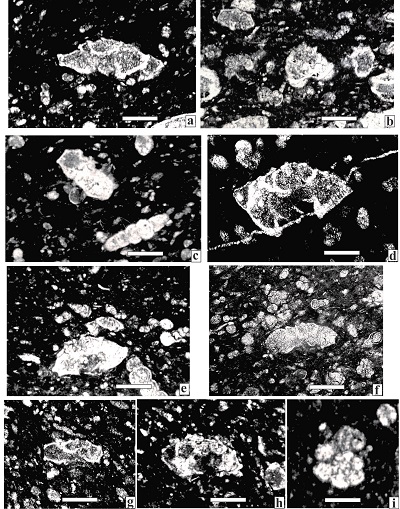 |
| Figure 6. Late Maastrichtian planktic foraminifera from the “Temazcal unit”. a) Globotruncana falsostuarti Sigal axial section, Sample CQ-03 (3); b) Contusotruncana walfischensis (Todd) axial section, Sample CQ-03 (2); c) G. hilli Pessagno axial section, Sample CQ-02b (10); d) Globotruncanita stuartiformis (Dalbiez) axial section, Sample CQ-02b (6); e) Globotruncana arca (Cushman) axial section, Sample CQ-03 (4); f) G. bulloides Vogler axial section, Sample CQ-02b (2); g) Abathomphalus mayaroensis (Bolli) axial section, Sample CQ-02b (2); h) G. aegyptiaca Nakkady axial section, Sample CQ-02b (3); i) Trinitella scotti Brönnimann transversal section, Sample CQ-03 (3). Scale bar 200 µm. |
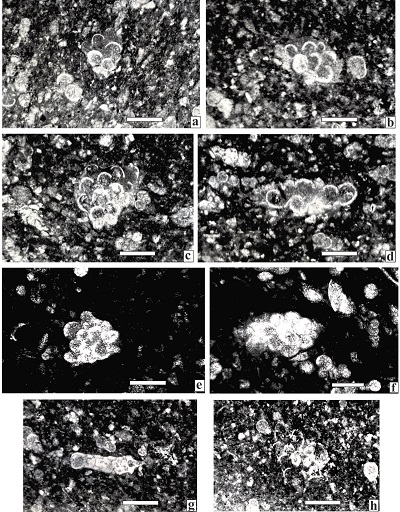 |
| Figure 7. Late Maastrichtian planktic foraminifera from the “Temazcal unit”. a - g) Planoglobulina acervulinoides (Egger), transversal section, Sample CQ-02b (4); h) P. multicamerata (de Klasz) transversal section, Sample CQ-03 (1). Scale bar 200 µm. |
Based on the planktic foraminiferal association, the age assigned to this succession is late Maastrichtian (Abathomphalus mayaroensis Interval Zone) according to the zonal schemes for tropical regions (Caron, 1985; Premoli-Silva and Sliter, 1995; Robaszynski and Caron 1995; Premoli-Silva and Verga, 2004). The age of this unit is correlated with the upper part of the Méndez Formation, cropping out in the eastern part of the VSLPP.
Evidence of an unconformity in the upper part of the El Abra Formation has been widely recognized. The unit has been overlain by units of distinct ages and recorded in different localities, so a controversy has existed since Kellum (1930, p. 78) indicated that the upper part of the Méndez Formation overlies the El Abra limestone, noting also that possibly the San Felipe Formation and the basal Méndez are absent in a section to the east and southeast of the Sierra El Abra. This view is confirmed by Muir (1936, p. 62), who suggests unconformable contacts between the El Abra and the San Felipe and Méndez formations. Bonet (1952) showed that the Méndez Formation crops out along the escarpment of the Sierra El Abra rests unconformably on the limestone of the El Abra Formation. Later, Pessagno (1969) concluded that the Campanian Méndez strata are in contact with El Abra Formation due to thrust faulting at southwest flank of Sierra El Abra northeast of Antiguo Morelos, Tamaulipas. Carrillo-Bravo (1971, p. 36-42) stated that in the Sierra de El Abra northeast of the Gómez Farias region, the Turonian Agua Nueva and San Felipe Formations disconformably overlie the El Abra Formation, while east of Jaumave it is covered by the San Felipe and the Méndez formations and in the Miquihuana area the El Abra Formation is capped by the Méndez Formation of Campanian-Maastrichtian age. All these localities are in the state of Tamaulipas.
Aguayo and Kanamori (1976) proposed the Tamuin Member of the mid-part of the Méndez Formation, suggesting that it overlies the El Abra Formation in angular unconformity.
Smith (1986, p. 148) stated that “during the Late Cretaceous certain areas were subaerially exposed on the VSLPP. The maximum hiatus recorded on the platform is where the Méndez Formation overlies El Abra, however the duration of the hiatus could be estimated depending on which strata overlie El Abra Formation at a given location.”
Basáñez et al. (1993) noted that various formations, such as the Agua Nueva, San Felipe and Méndez, covered the El Abra Limestone at the eastern part of the VSLPP.
It is important to point out that although the El Abra unconformity has been recognized on the VSLPP platform for a long time, the present study has enabled the magnitude of the hiatus between the El Abra Formation and the “Temazcal Unit” in the Cerro Quemado locality to be established. The gap would be from the early Turonian deposit up to the early Maastrichtian, based both on the stratigraphic relationships and on the exhaustive micropaleontologic and petrographic studies.
Since the Turonian–early Maastrichtian, the area occupied by the Valles–San Luis Potosí Platform was located within the foreland zone and involved in the contractive deformation of the Mexican Orogeny (Juárez-Arriaga et al., 2019). As an uplifted basement block since the Late Jurassic, during the Early Cretaceous this area was flooded by a shallow sea with a proliferation of reefs and lagoons, surrounded by relatively deeper basins. These basinal areas have been grouped as the Mexican Foreland Basin (Juarez-Arriaga et al., 2016, 2019). In such a scenario, the Valles San Luis Potosí was a part of the forebulge zone of the Mexican orogen in front of the foreland basin and reached an elevated position by tectonic effects, experiencing marine regression from the Turonian, with only ephemeral transgressions towards the late Maastrichtian as documented at least for the area of our study.
- Conclusions
We have studied the foraminiferal assemblages and microfacies from the El Abra Formation, which is uncomformably overlain by the Temazcal unit, located in the Cerro Quemado.
The El Abra Formation was deposited on a carbonate platform. The upper part shows an abrupt topographic profile produced by erosion. This unit has been dated as mid–late Cenomanian based on the benthic foraminiferal associations, while the age assigned to the “Temazcal unit” from the study of the planktic foraminifera is late Maastrichtian, deposited in a deep basin environment.
From an evaluation of the biostratigraphic data in the studied locality we have inferred a horizon where rocks of the early Turonian to early Maastrichtian are absent due to non-deposit and erosion.
It is important to note that although previous works have referred to the El Abra Formation gap and the various lithologic units covering it as the San Felipe and Méndez formations, this work is a significant contribution because we have documented this event through precise dating based on a foraminiferal study and microfacies analysis from the strata found in the zone of contact between the El Abra Limestone and the overlying “Temazcal unit.”
Contributions of authors
Conceptualization: L. Omaña, R. López-Doncel, J.R. Torres-Hernández and J.R. Barbosa-Gudiño. Data acquisition: L. Omaña, R. López-Doncel, J.R. Torres-Hernández and J.R. Barbosa-Gudiño. Methodologic development: L. Omaña, R. López-Doncel, J.R. Torres-Hernández and J.R. Barbosa-Gudiño. Writing of original manuscript: L. Omaña.
Writing of the corrected and edited manuscript: R. López-Doncel and J.R. Barbosa-Gudiño. Graphic design: L. Omaña, R. López-Doncel, J.R. Torres-Hernández and J.R. Barbosa-Gudiño. Fieldwork: L. Omaña, R. López-Doncel, J.R. Torres-Hernández and J.R. Barbosa-Gudiño. Interpretation: L. Omaña, R. López-Doncel, J.R. Torres-Hernández and J.R. Barbosa-Gudiño.
Financing
The work was supported by Universidad Nacional Autónoma de México DGAPA-PAPIIT IN119208 Project grants.
Acknowledgements
The authors wish to acknowledge the Instituto de Geología of the Universidad Nacional Autónoma de México and the Instituto de Geología of the Universidad Autónoma de San Luis Potosí for endorsing this study. We thank two anonymous reviewers for their helpful comments that significantly improved this manuscript. We are deeply thankful to Drs. Antoni Camprubí and Francisco Vega, Editors-in-Chief (Instituto de Geología UNAM), for their careful editorial handling of our article. We thank Fernando Núñez for the description of the microfacies; to Joaquín Aparicio for preparing numerous thin sections, and to Rubén Cruz for taking the photos and drawing the section.
Conflicts of interest
The authors state that they do not have any conflicts of interest with other authors or institutions, and they declare that this journal is not accountable for any conflict of interest occurring after the publication of the article.
References
Aguayo, C. E., Kanamori, K., 1976, The Tamuin member of the Mendez Shale along eastern flank of the Sierra de El Abra, San Luis Potosí, east Mexico: Boletín de la Sociedad Geológica Mexicana, 37(1), 11–17. http://dx.doi.org/10.18268/BSGM1976v37n1a2
Alencáster, G., García-Barrera, P., 2008, Albian Radiolitid rudists (Mollusca-Bivalvia) from East–Central Mexico: Geobios, 41(5), 571–587. https://doi.org/10.1016/j.geobios.2008.04.001
Basáñez, L. M. A., Fernández-Turner, R., Rosales, D. C., 1993, Cretaceous Platform of Valles-San Luis Potosí, Northeastern central Mexico. In Simó, J. A., Scott, R. W., Masse, J. P. (Eds.), Cretaceous Carbonate Platforms: American Association of Petroleum Geologists, Memoir, 56, 51–59. https://doi.org/10.1306/M56578
Buitrón-Sánchez, B. E., Carrillo-Martínez, M., Rosales-Domínguez, M. D. C., Aguilera-Franco, N., 1995, A middle Albian biota (Algae, Foraminifera and Gastropoda) from Ahuacatlán State of Querétaro, Mexico: Revista Mexicana de Ciencias Geológicas, 12(2), 145–156.
Bonet, F., 1952, La facies urgoniana de Cretácico medio de la Región de Tampico: Boletín de la Asociación Mexicana de Geólogos Petroleros, 4, 153–262.
Bonet, F., 1956, Zonificación microfaunística de las Calizas cretácicas del Este de México: Boletín de la Asociación Mexicana de Geólogos Petroleros, 8, 389–489.
Caron, M., 1985, Cretaceous Planktic Foraminifera. In Bolli, H. M., Saunders, J. B., Perch-Nielsen, K. (Eds.): Plankton Stratigraphy, Cambridge University Press, 17–86.
Carrillo-Bravo, J., 1971, La Plataforma Valles-San Luis Potosí: Boletín de la Asociación Mexicana de Geólogos Petroleros, 23, 1–102.
Cserna, E. G., Bello-Barradas, A., 1963, Geología de la Sierra de Álvarez, Municipio de Zaragoza, San Luis Potosí: Boletín del Instituto de Geología, UNAM, 71, 23–63.
Fitz-Díaz, E., Lawton, T. F., Juárez-Arriaga E., Chávez-Cabello G., 2018, The Cretaceous-Paleogene Mexican orogen: Structure, basin development, magmatism and tectonics: Earth-Science Reviews, 183, 56–84. https://doi.org/10.1016/j.earscirev.2017.03.002
Flügel, E., 2010, Microfacies of carbonate rocks. Analysis, interpretation and application, 2nd Ed.: Berlin, Springer, 984 p.
Juárez-Arriaga, E., Lawton, T. F., Stockli, D. F., Solari, L, Martens, U., 2019, Late Cretaceous-Paleocene stratigraphic and structural evolution of the central Mexican fold and thrust belt, from detrital zircon (U-Th)/(He-Pb) ages: Journal of South American Earth Sciences, 95, 102264, 1–17. https://doi.org/10.1016/j.jsames.2019.102264
Kellum, L. B., 1930, Similarity of surface geology in front ranges of Sierra Madre Oriental to subsurface in Mexican South fields: The American Association of Petroleum Geologists, Bulletin, 14, 73–91.
Labarthe-Hernández, G., Tristán-González, M., Aranda-Gómez, J. J., 1982, Revisión estratigráfica del Cenozoico de la parte central del Estado de San Luis Potosí: Universidad Autónoma de San Luis Potosí, Instituto de Geología y Metalurgia: Folleto Técnico, 85, 205 p.
López-Doncel, R., 2003, La Formación Tamabra del Cretácico medio en la porción central del margen occidental de la Plataforma Valles–San Luis Potosí, centro–noreste de México: Revista Mexicana de Ciencias Geológicas, 20, 1–19.
Muir, J. M., 1936, Geology of Tampico region, Mexico: American Association of Petroleum Geologists, Tulsa Oklahoma, 280 p. https://doi.org/10.1306/SV8338
Omaña, L., López-Doncel, R. Torres-Hernández, J. R., Alencáster, G., 2012, Biostratigraphy and Paleoenvironment of the Cenomanian–Turonian boundary interval based on foraminifera from W Valles-San Luis Potosí Platform, Mexico: Micropaleontology, 58(6), 457–485.
Omaña, L., López-Doncel, R., Torres-Hernández, J. R., 2013, Late Cretaceous (Cenomanian-Santonian) foraminiferal biostratigraphy from W Valles-San Luis Platform, Mexico: 9th Symposium of Cretaceous System, Ankara, Turkey, 94 p.
Omaña, L., López-Doncel, R., Torres-Hernández J. R., Alencáster, G., López-Caballero, I., 2019, Mid–late Cenomanian larger benthic foraminifers from the El Abra Formation W Valles-San Luis Potosí Platform, central-eastern Mexico: Taxonomy, biostratigraphy and paleoenvironmental implications: Boletín de la Sociedad Geológica Mexicana, 71(3), 691–725. https://doi.org/10.18268/bsgm2019v71n3a5
Pessagno, E.A., 1969, Upper Cretaceous stratigraphy of the western Gulf Coast Area: Geological Society of America, Memoir, 111, 139p. https://doi.org/10.1130/MEM111-p1
Premoli-Silva, I., Sliter, W.V., 1995, Cretaceous planktonic foraminiferal biostratigraphy and evolutionary trends from the Bottaccione section, Gubbio, Italy: Paleontographia Italica, 82, 1–89.
Premoli-Silva, I., Verga, D., 2004, Practical manual of cretaceous planktonic foraminifera. International School on Planktonic Foraminifera. 3rd Course: Cretaceous. Verga, D., Rettori, R., (Eds.). Universities of Perugia and Milan. Tipografia Pontefelcino, Perugia, Italy, 462 p.
Robaszynski, F., Caron, M., 1995, Foraminifères planctoniques du Crétacé: commentaire de la zonation Europe-Méditerranée: Bulletin de la Société Géologique de France, 166(6), 681–692.
Salvador, A., 1991, Origin and development of the Gulf of Mexico basin. In Salvador, A., (Ed). The Gulf of Mexico Basin: Boulder, Colorado, Geological Society of America, 389–444. https://doi.org/10.1130/DNAG-GNA-J.389
Scott, R. W., 1990, Models and Stratigraphy of mid–Cretaceous reef communities, Gulf of Mexico. In Lidz, B. H. (Ed.), SEPM Concepts in sedimentology and paleontology, 2, 1–99. https://doi.org/10.2110/csp.90.02
Smith, B. A., 1986, Upper Cretaceous stratigraphy and the mid–Cenomanian unconformity of East-Central Mexico. The University of Texas at Austin, Ph. D. thesis, 188 p.
Suter, M., 1984, Cordilleran deformation along the eastern edge of the Valles–San Luis Potosí carbonate Platform, Sierra Madre Oriental fold thrust east-central Mexico: Geological Society of America, Bulletin, 95, 1387–1397. https://doi.org/10.1130/0016- 7606(1984)952.0
Suter, M., 1987, Structural transverse across the Sierra Madre Oriental fold thrust east-central Mexico: Geological Society of America, Bulletin, 98, 249–264. https://doi.org/10.1130/0016-7606(1987)98<249:STATSM>2.0.CO;2
Suter, M., 1990, Geología de la Hoja Tamazunchale, Estados de Hidalgo, Querétaro y San Luis Potosí: México,Instituto de Geología, 55 p.
Wilson, J. L., 1975, Carbonate Facies in Geologic History: New York, Springer Verlag, 449 p. https://doi.org/10.1007/978-1-4612-6383-8
Wilson, J. L., Ward, W. C., 1993, Early Cretaceous carbonate platforms of northeast and east central Mexico. In Simó, J. A., Scott, R. W., Masse, J. P. (Eds.), Cretaceous carbonate platforms: American Association of Petroleum Geologists, Memoire, 56, 35-49.
Manuscript received: February 3, 2021
Corrected manuscript received: July 7, 2021
Manuscript accepted: August 24, 2021
Peer Reviewing under the responsibility of Universidad Nacional Autónoma de México.
This is an open access article under the CC BY-NC-SA license(https://creativecommons.org/licenses/by-nc-sa/4.0/)

